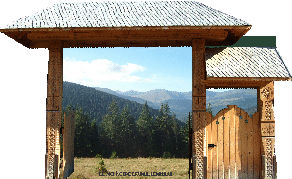THE ROAD OF WOOD IN BUCOVINA
 Somewhere, in the North of Romania, defended by the picks of the Carpathians and bearing, like them, the scar of the border line established here by the enemy's sword, there lies a particularly distinct territory – Bucovina. The word “distinct” refers to Bucovina as a whole: nature, people, customs, traditions, which have been preserved unchanged until today, when the spirit runs a little bit wild and the old rituals are slowly burried in oblivion.
Somewhere, in the North of Romania, defended by the picks of the Carpathians and bearing, like them, the scar of the border line established here by the enemy's sword, there lies a particularly distinct territory – Bucovina. The word “distinct” refers to Bucovina as a whole: nature, people, customs, traditions, which have been preserved unchanged until today, when the spirit runs a little bit wild and the old rituals are slowly burried in oblivion.
Bucovina – the High Land of Moldavia, as the contemporaries of Stephen the Great used to call it, is a prisoner of history, of legend too, held with big golden spikes on whose flower glitter, unique in the world, like genuine symbols of faith and steadiness, the mediaeval monasteries.
The one who desires to meet places and people of Bucovina can focus on a destination like a little town at the heart of this region – Campulung Moldovenesc and the villages which surround it.
Situated in a 11-kilometer long depression along the Moldova river, on its unevenly developed terraces, the location perfectly corresponds to the widely spread popular term of “campulung” (translatior's note: long field) and is guarded, in the South, by the pre-christian altar of the High Land – the Rarau mountain.
The history of Campulung of Bucovina is very old, if we take into account the archeological discoveries dating back in the carved stone age (axes, knives, silex arrowheads) and located in the Est part of the town. The first documents and written evidence date back in the 12th century (in the logbook of Mr. Johann Wendel) and another one since April 14, 1411 from the time of Alexandru cel Bun (the Good Alexander).
In the Middle Ages, the town of Campulung was the center of a group of settlements of yeomen who possessed, in common, the surrounding mountains. It was privileged to have a unique status among the Romanian territories, like some kind of a “republic”, almost independent from the reign, which was called “The Bounds of Campulung”. In his book, “The Description of Moldavia”, D. Cantemir referred to this region as “...having existed before the Reign, and its autonomy was respected and not created”.
The free people living in the mountains of Bucovina have always had three fulcrums which have helped them with their every day life and endurance: their faith in God, the animals in the courtyard and the forest.
The forest has given them shelter, food and especially wood. It is almost incredible how the people of Bucovina have known how to use this gift of the forest in everything that has meant their domestic and spiritual life.
That's why within the Romanian boundaries one can speak about a real “civilization of wood”, which can be seen both in the peasant architecture and in the art of processing the wood in artistic forms, so necessary to the people of these places, since old times up to nowadays.
The fact that the Romanian territory has been blessed with large forests, once spread on 70 % of the whole surface, fully explains the appearance of a wood civilization which has developed in time and which has been brought to its finest form in the county of Suceava, the region which possesses the largest forest area in the country.
The forest used to provide people, directly or indirectly, with shelter, clothes, food (fruit, mushrooms, edible plants, game, fish, honey and others). Until the beginning of the 20th century, one could meet houses and other constructions without any iron nails, while the only metal things that the Carpathian sheepfolds had were the cast-iron kettle and other few tools. During the great invasion of objects, tools and industrial machines, the baby's cradle and the coffin continue to be made entirely of wood in the countryside.
The forest existing within the Carpathian-Danube limits was, for hundreds of years, the inexhaustible source of row material for the appearance and development of certain specific crafts. That is why one can speak about a real “wood civilization” on the Romanian territory, which can be noticed both in the peasant architecture and in the art of processing the wood in artistic forms, so necessary to the people of these places, since old times until nowadays.
Inițiativă locală. Dezvolater regională
www.inforegion.ro
Investim în viitorul tău!
Proiect selectat în cadrul Programului Operaţional Regional şi co-finanţat de Uniunea Europeană prin Fondul European pentru Dezvoltare Regională.
Conţinutul acestui material nu reprezintă în mod obligatoriu poziţia oficială a Uniunii Europene sau a Guvernului României.
Toate drepturile de autor aparţin U.A.T. Câmpulung Moldovenesc şi Consiliului Judeţean Suceava